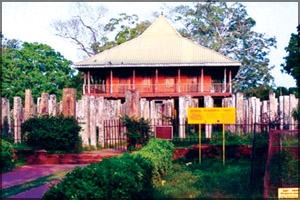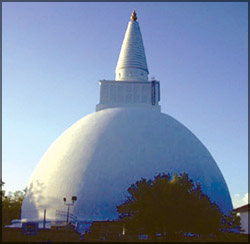Dutugemunu unites the country
 After the victory, Dutugemunu became the undisputed king of Lanka. He
united the country after defeating the invaders who occupied the seat of
government in Anuradhapura. After the victory, Dutugemunu became the undisputed king of Lanka. He
united the country after defeating the invaders who occupied the seat of
government in Anuradhapura.
All his warriors were richly rewarded according to their ranks. But
there was one warrior, Theraputtabhaya, who did not accept what was
offered to him. The King summoned him and asked him what was wrong.
He answered, “O King! The war was won. Now, the country is united
after we defeated the invaders”. “What do you want to do?” the King then
asked. Theraputtabhaya respectfully said, “I will fight against the
passions of life. It is difficult to win against such forces”.
The King tried to restrain him, but found it difficult. With the
permission of the King, Theraputtabhaya retook to robes and went to live
with 500 monks.
|

Lovamahaprasada |
After celebrating the great victory for a week, the consecration
ceremony was held with pomp and pageantry, ending with the water
festival held at Tissa Weva.
It was on the Esala full moon day in 149BC (i.e. 2,147 years ago),
that the foundation stone was ceremonially laid for the building of the
Maha Thupa (Ruwanveliseya) in Anuradhapura, by King Dutugemunu
(161-137BC) in the fulfillment of his religious duty towards Buddhism.
After ascending the throne in the Second Century BC, he built the
Mirisavetiya and Ruwanveliseya stupas and Lovamahaprasada (Brazen
Palace).
The latter was called by that name because its roof was covered with
brazen(brass) tiles. This nine-storeyed building stood on stone pillars
and had a thousand chambers to house Buddhist monks who gathered to
perform uposatha - to decide on incidents when monks violate vinaya
rules. Lovamahapaya was the tallest building in Anuradhapura. It was 200
feet tall and 200 feet wide and resembled the palace of Goddess Barani.
It was here that monks assembled and had discourses(lectures) on the
Dhamma. Saddhatissa who succeeded his brother King Dutugemunu, rebuilt
this building which was destroyed in a fire.
The building was reduced from nine storeys to five by King
Saddhatissa. The kings who succeeded him - Tullatthana, Sirinaga I, Sena
I and Parakramabahu I - renovated Lovamahapaya and made it an important
part of the Maha Vihara.
The story of Dutugemunu is familiar, but many may not be aware that
he married the daughter of a rebel chieftain who continued to pay
tributes to King Elara. Ran Etana, the chieftain’s daughter who went
against her father’s wishes, joined Dutugemunu, personally leading an
army of stalwart youths and maidens to help him conquer Elara.
Saliya and Asokamala
Dutugemunu and Ran Etana’s son Saliya married a beautiful maiden of
the scavenger caste (Chandala), thereby disqualifying himself from
inheriting the throne.
|

Mirisavetiya |
The Mahawansa says “Dutugemunu had a son named Saliya who was
virtuous(morally good) and indulged(took pleasure) in a life with
constant meritorious deeds. He had an affair with a low caste girl who
had been connected with him in his past lives. She had enchanting
beauty; Saliya willingly gave up the kingdom for her”. (Mahawansa -
Chapter 33)
Saliya started life in the girl’s village. Once, the King visited
this area and Asokamala sent him a curry made of a delicious herb called
raththampala. The king was overjoyed to see this dish and inquired as to
where it came from. The servants replied, “Your honour, it is from
Asokamala.” The king glistened with rage and slammed the dish on the
wall.
Time passed, but King Dutugemunu’s granite-like heart never softened
towards his son. He held on, just like his giant stone buildings in
Anuradhapura. Once he found a wound in his leg caused by a small
blister. It was so painful and the royal doctors were summoned. They did
their best, but the wound turned worse.
The final prescription needed raththampla, but it was nowhere to be
found. One servant remembered the pulp which had dried on the wall and
immediately a royal guard was sent to scratch it out. Soon the medicine
was made and the wound was cured. Then the king enquired from where they
got raththampala.
The servants, amidst the greatest fear, related the story and the
King felt sorry for Asokamala. Soon, the couple were summoned to the
palace and an official wedding ceremony was arranged. The King was very
pleased to see the pretty Asokamala and they were pardoned for the
‘crime of love’.
Death of King Dutugemunu
According to legend, King Dutugemunu died when he was stung on his
head by a Naga who had been in a coconut pandal.
King Dutugemunu was succeeded by his brother Saddhatissa who
completed Ruwanveliseya and Lovamahapaya which were started by King
Dutugemunu.
After Saddhatissa, his son Valagamba succeeded to the throne. There
was an invasion of Anuradhapura by the Pandyans and the King had to live
in exile for 14 years. King Valagamba, also known as Vattagamini Abhaya,
built Abhayagiri Vihara. Thus there came into existence two main viharas,
namely Mahavihara and Abhayagiri.
Compiled by Janani Amarasekara
|
